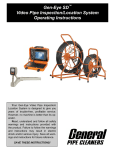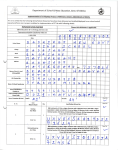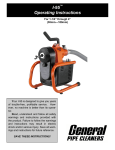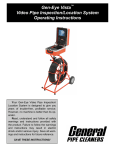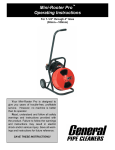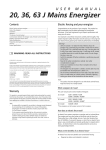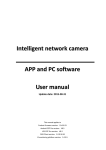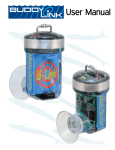Download Gen-Ear LE - General Pipe Cleaners
Transcript
Operating Instructions for General Gen-Ear LE ™ Water Leak Location System Your Gen-Ear LE is designed to give you years of trouble-free service. However, no tool is better than its operator. We therefore suggest you read these instructions carefully before using your tool on the job. This will enable you to operate the Gen-Ear LE more safely and effectively. SAVE THESE INSTRUCTIONS! Gen-Ear LE™ Although the Gen-Ear LE is the most advanced leak location system you can buy, it takes patience and practice to master the art of finding hidden water leaks. Read the instructions carefully to save time in becoming a leak location professional. Failure to follow these instructions may cause personal injury to the operator or damage to the equipment. 2. High Performance Headphones— Designed to give the clearest sound with the least interference from ambient noise. Note: Amplifier will not work unless headphones are plugged in. 3. Ground Sensor—3-point ground plate locates leaks through hard surfaces, concrete, tile, etc. Threaded nipple accommodates sectional probe rods for locating leaks under soft surfaces such as grass or carpet. Magnet threads on to Sensor to listen to above ground pipes, faucets, and hydrants. Wind proof, shock resistant housing protects against handling noise interfering with locating process. SAFETY INSTRUCTIONS Avoid possible damage to your hearing by always starting out with the volume control at the lowest setting (counter-clockwise). Use the Mute button to protect your hearing. Release the Mute button when you experience sudden loud noises. 7 Do not press the Mute button while sensor is in motion. Wait to press the Mute button until sensor is in place. 2 SAVE THESE INSTRUCTIONS! ! CAUTION 5 ! 1 4 The Gen-Ear LE sensor is a ceramic piezoelectric element. It can be broken if it is dropped onto concrete or other hard surfaces from only 18 to 24 inches, or if it is physically shocked in some other way. If the element is broken due to harsh treatment, it must be replaced at the owner’s expense, and it will not be covered under warranty. The sensor is covered under the Gen-Ear LE’s warranty against manufacturing defects and against failures during ordinary use and handling. 3 6 4. Probe Rods— For water leak searches in areas covered by loose soil, grass, or carpeted floors over the water line. Three one-foot probe rods thread into bottom of the ground sensor to allow easy sound sampling while operator is in a comfortable position. To use, attach the probe rod to the brass thread on the base of the ground sensor. If only a short rod is needed, attach only the pointed section of the probe rod to the bottom of the ground sensor. For deep brass valves at curb stops, use all three sections of the probe rod. Push the point of the contact rod firmly against the brass valve. COMPONENTS 1. Amplifier—Has built-in preset audio filters, low battery indicator light, and volume control housed in a heavy-duty case. Safety mute button protects the operator from sudden loud noises. Unit automatically shuts down when the headphones are removed to extend battery life. Power light blinks when batteries are low. Operates on two “AA” batteries. 2 Gen-Ear LE™ 5. Magnet Base for Hydrants and Valves – The magnet base threads onto the ground sensor to more easily survey leaks at cast iron fire hydrants, water mains, iron valves, or steel water pipes and fittings. The magnet base can be used with or without the 3-pronged base. The magnet should be hand-tightened only onto the brass screw thread of the ground sensor. knob counter-clockwise to deactivate the unit or to decrease the sound level. Always adjust the volume control to a low level (10% to 25%) when first putting on the headphones and before depressing the mute button. Increase the volume gradually until the water leak sounds can be heard easily but without distortion. Reduce the volume if there is distortion of the sound. To turn on the built-in flashlight, depress the control knob. High and Low Frequency Filters The Gen-Ear LE has a preset low frequency filter set at 100 Hz and a high frequency filter set at 1000 Hz. This enables the unit to filter out all noises and sounds at 100 Hz frequency and lower, and at 1000 Hz frequency and higher. The filters eliminate most extraneous noises, such as traffic and wind, which would interfere with hearing a leak clearly. 6. Sound Amplification Manifold (SAM)— Module helps to amplify hard to hear leaks by pressurizing the water line with air. 7. Carrying Case—Made of high-density polyethylene. Designed to withstand heavy use. Foam cutouts to hold all components listed above. AMPLIFIER FEATURES INTRODUCTION TO LEAK LOCATION Battery Power and Battery Check Light The low battery indicator is integral with the amplifier’s power light. The light will remain lit as long as the unit is turned on and the batteries are in good condition. If the battery power is low, the light will flash on and off. Replace the batteries immediately. Leak sounds are created by three different situations: 1. The vibration of the pipe caused by water forced through a crack in the pipe. Pipe vibration is the loudest and easiest to detect. It sounds like a “whoosh” or a “hiss.” Mute Button The mute button on the amplifier should be depressed only when the ground sensor and cables are completely stationary and you are ready to hear the leak. Sound will not be heard until the mute button is depressed. The mute button must be released before moving the ground sensor in order to protect your hearing. The mute button is specifically designed for this purpose. 2. Water forced through the crack and hitting the surrounding soil, sounds quieter and is affected by the type of material around the pipe. If it’s rock or gravel, a “hammering” or “knocking” sound may be heard. If loose soil surrounds the pipe, it may be difficult to hear anything at all. 3. Water flowing through the soil cavity will create a “gurgling” sound like a small stream or brook. Volume Control, On/Off switch and Built-In Flashlight Turn the volume control knob clockwise to activate the unit and increase the sound level. Turn the volume control The loudness and frequency of leak noise is affected by water pressure, pipe material, soil density and type, depth of the pipe, and type of surface (i.e. concrete, grass, etc.) The higher the water pressure, the louder the leak sounds will be. If you are having difficulty finding a leak, use the Sound Amplification Manifold (SAM) that injects air into the water line in order to increase the water pressure at the site of the leak. (See below). 3 Gen-Ear LE™ Knowing the type of pipe is helpful. Metal pipes transmit sounds at a higher frequency. In cast iron, copper and steel pipes, you are most likely to hear leak sounds in the range of 400 Hz to 1200 Hz. In PVC pipe, leak sounds resonate in the range of 200 Hz to 600 Hz. Main Line Sound Transmission Chart Pipe Pipe Maximum Material Diameter Distance Cast Iron 6” 500 to 1000 ft. PVC 6” 200 to 300 ft. Pipe size, no matter what material, affects frequency and sound levels as well. Water leaks from larger pipes transmit less sound and at lower frequencies than smaller pipes. Frequency Chart Pipe Material Cast Iron PVC Pipe Low Frequency 400 Hz 200 Hz High Frequency 1200 Hz 600 Hz Loose or sandy soil, swampy or water-saturated areas, as well as newly buried pipe produce muffled leak sounds that can be harder to find. Thus, a pipe that’s been leaking for some time will absorb the leak vibrations making it much more difficult to find. Pipe in hard or rocky ground transmits leak sounds best. The combination of high-end and low-end filtering will remove the extraneous noises of equipment, wind, traffic, etc. The Amplifier has built-in audio filters preset to 100 Hz low and 1000 Hz high. The deeper the pipe, the harder it will be to find the leak because soil absorbs leak sounds quickly. It’s difficult to find leaks in lines buried deeper than 8 feet. To find leaks in deeper lines, the water pressure must be increased to amplify the sound. The surface material also will affect the amplification of leak noises. A hard surface like concrete will resonate with the sound of a leak for 5 to 10 feet around the water pipe, while grass and earth do not assist in the amplification of leak noise. Select the proper sensor for the surface on which you are locating. The leak vibration travels down the length of the pipe as well. In 6” cast iron main lines leaks can be detected as far as 500 to 1000 feet away, while a 6” PVC pipe may only transmit the vibration 200 to 300 feet down the line. The probe must be placed directly on the pipe wall to detect the leak at these distances. 4 Gen-Ear LE™ such as grass or carpet. Use the magnet on above ground pipes or hydrants. OPERATION 1. Plug the headphones into Amplifier. Note: The unit will not work unless headphones are plugged in. 6. Start the pinpoint process by moving the sensor directly over the water line in onefoot increments. As you get closer to the actual leak, the sound will increase in the headphones. 2. Turn Amplifier volume on/off switch on. The light in the switch will blink when the batteries are low. Replace with two “AA” Alkaline batteries. ! CAUTION 7. Once the leak has been pinpointed, mark its location. You should be within one foot of the leak. 8. If the leak sound isn’t loud enough for positive location or outside noise is interfering, use the Sound Amplification Manifold (SAM). PINPOINTING A LEAK—WATER LEAK SURVEY ! The Gen-Ear LE has a high level of output. Always start with the volume control at the lowest setting (counter-clockwise), then proceed slowly, adjusting upward for the maximum sound. The most common indicators of a domestic water leak are a dramatic increase in a water bill or hearing water running all the time. If you don’t see any obvious evidence of a major water leak, like “ponding” or loud leak sounds, then start a water leak survey. Use the Sensor and Probe Rods or magnet to survey the hydrants and main valves. If you hear the sound of a leak at one location, check lines running in all directions from that point. The leak location is usually found between the loudest and second loudest survey locations. Then you can begin to narrow down your search. 3. Depress and hold the mute button to listen to sound from sensor. ! CAUTION ! Do not press the mute button while sensor is in motion. Wait to press the mute button until sensor is in place. 4. Make direct contact with Sensor and Probe Rods or magnet to all sink lines, hot water heater lines, and hose bibs. This gives you a general location of the leak. The leak location is usually found between the loudest and second loudest survey locations. Then you can begin to narrow down your search. 5. Use either the Ground Sensor or the Probe Rods, depending upon the surface on which you are locating. The Ground Sensor is used when locating water leaks through hard surfaces, concrete, asphalt, tile, etc. Select the Probe Rods when locating water leaks under soft surfaces 5 Gen-Ear LE™ Start by locating the route of the water line by using General’s Gen-Eye pipe Locator and Transmitter. SOUND AMPLIFICATION MANIFOLD (SAM) The Gen-Ear LE Sound Amplification Manifold adds air to the water line, which increases the leak pressure and thus increases the leak sound making it much 1. Attach the Transmitter leads to each end of the pipe to be located, then turn the Transmitter on. 2. Turn on the Locator and set the frequency to Pipe Location Mode (65 KHz). easier to pinpoint even the most difficult leak. 1. Attach the end of the SAM to a nearby hose bib. 3. Make sure the blade of the Locator is perpendicular to the ground and across the pipe (rather than in-line). 2. Then, attach the air compressor to the inlet of the SAM. 4. Mark the surface as you locate the path of the water line. 3. Turn the pump on and open the valve on the SAM. After you’ve traced the water line, walk the marked path with the Gen-Ear LE senor, taking a reading every 3 or 4 feet. Follow the flow of the water line, from upstream to downstream, and note each reading. Do not adjust the volume control. The volume must remain constant in order to make accurate comparisons. When you are very close to the leak, you will be able to discern the location of the leak with your hearing alone. 4. Then open the hose bib valve. You should hear an instant amplification of the leak noise. Once you’ve pinpointed the leak and marked its location, it’s a good idea to double-check your mark by turning off the air while listening to the marked area. If you’ve got the right location, the leak sound should dissipate. This assures that you’ve found the leak, not some other outside noise. ! WARNING! ! When using the Sound Amplification Manifold (SAM), do not let air pressure exceed water pressure by more than 10-15 psi, or toilet float valves, water tanks and faucet valves could be damaged. To be safe, shut off all fixture and water heater valves. Dealing With Extraneous Noises Often there are extraneous noises at a water leak job site, such as traffic, wind, AC hum, etc., that can make leak location difficult, particularly water leak pinpointing on the street. 6 Gen-Ear LE™ Walk 15 feet away from the water line to an area of the pavement identical in surface to that over the water line, but without any water lines or other utilities anywhere beneath it. If it is windy, block the wind’s flow around the sensor and cable with your body. Familiarize yourself with any extraneous noises that are present with the ground sensor on the street at this location away from the water line. Return to the water line and ignore all the extraneous noises and concentrate on the unique sounds that are present only over the water line. TIPS FOR BEGINNERS If you are new to leak location, you must learn the sound of a leak before you start your search. Set up the Gen-Ear LE with one Probe Rod. Touch the tip of the Probe Rod to the cold water line under a sink. Then turn on the valve just a little bit so the water is dribbling out of the faucet. This simulates the sound of a leak. Turn the valve on and off as you listen until you hear the difference. The rest of leak location is a process of elimination. Assume that you’ve got a leak if the water meter is registering water flow, yet all the valves in the house are closed. The rest of your job is to isolate the leak. Use the Probe Rod or magnet on all sink lines, hot water heater lines, and hose bibs to get a general location of the leak. Suspect older parts of the system or areas with a history of leaks, and of course, any recent excavations. This method is also very effective when the leak is very small, or very quiet, and you are not even certain that what you hear is the leak. In this situation, move 15 feet away from the water line and listen. If you hear the same sounds as before, then you were not hearing the sounds of a water leak. TROUBLE SHOOTING GUIDE Fault Amplifier will not turn on Remedy Check that the headphones are plugged in. Check the battery strength. Check all connections. Check that the Ground Sensor plate, Probe Rods, or magnet is tight. Press and hold mute button when locating. The Sensor can be damaged by dropping it from as little as 12” to 24” onto a hard surface. Use caution when handling the senor. If it is damaged due to a fall, it must be replaced. No sound from sensor Ground Sensor failure QUESTIONS? If you have any problems or questions, call the Drain Brains® at 800-245-6200 or 412-771-6300. 7 Gen-Ear LE™ GENERAL'S LIMITED WARRANTY General Gen-Ear LE water leak locator carries a one-year warranty against defect in materials except as noted below. Should any part break or fail to work properly in the one year following purchase, it will be repaired or replaced at our discretion at no charge. Damage due to negligence, improper usage, failure to follow instructions, accidents, or alteration from original design is not covered by this warranty. In order to handle any adjustment with a minimum of delay, please follow this procedure: 1. Return the part to your wholesaler, and have them notify us immediately, with complete information on the problem. 2. We must have the serial number, the date of purchase, and the name of the wholesaler from whom you tool was purchased. To activate your Gen-Ear LE warranty, your warranty card, which has this information, must be filled out and sent to us immediately after your machine is purchased. 3. We will then advise your wholesaler if the part should be returned to us and assign a return goods authorization (RGA) number. Ship freight prepaid, and you will be compensated for these charges if it is determined that the part is defective. If repairs are necessary due to conditions beyond our control, or if the item is out of warranty, we will do the work at the lowest possible cost, but a charge will be made. This warranty is made in place of all other warranties, express, statutory or implied, including those of merchantability and of fitness for purpose. General shall not be responsible for any incidental or consequential damages. This warranty gives you specific legal rights, and you may also have other rights which vary from state to state. Some states do not allow the exclusion of limitation of incidental or consequential damages, so these limitations may not apply to you. General Wire Spring Co. 1101 Thompson Avenue McKees Rocks, PA 15136 USA © 2007 General Wire Spring GRLE-OI-0307 8








